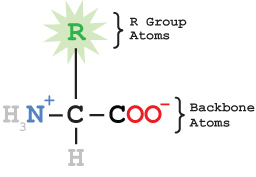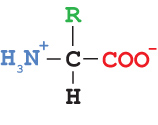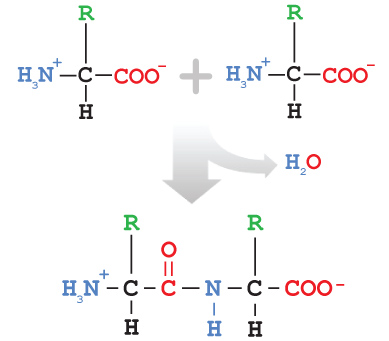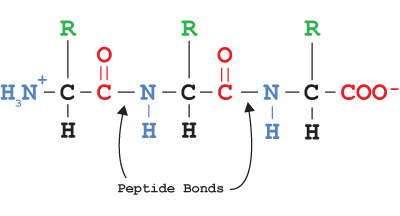Proteins are built from twenty different amino acids, arranged in a specific order, like beads on a string. The order of the amino acids in the protein is called the primary structure of the protein. Each amino acid shares a common set of atoms that make up the amino acid backbone. Attached to the central carbon atom (the alpha carbon) is an atom or group of atoms that varies among the amino acids, making them all different. This group is sometimes called the R group or amino acid sidechain.
The chemical structure of a single amino acid is shown below, using CPK coloring scheme (except for the R group, which is in green).

Click the buttons below to see the same amino acid structure in Jmol.
Each amino acid contains an amino group, a carboxylic acid group, an R group and a hydrogen atom attached to the central alpha carbon.

Click on each of the buttons below to see the labeled portion of the molecule colored yellow.
The twenty amino acids found in proteins only vary in their R groups, or sidechains. These functional groups provide unique properties important both in the way proteins fold and in the way proteins function. Amino acids are typically grouped into four classes. Below are examples of each class of amino acid, displayed using CPK coloring.
Hydrophobic Leucine is an amino acid with a hydrophobic R group.
Polar Histidine is an amino acid with a polar R group.
Positively Charged Arginine is an amino acid with a positively charged R group.
Negatively Charged Glutamic acid is an amino acid with a negatively charged R group.
 What color and types of atoms make up each of the four R groups that you just looked at?
What color and types of atoms make up each of the four R groups that you just looked at?
Amino acids are joined together via a condensation reaction (sometimes called dehydration synthesis). This reaction, as the name implies, releases a water molecule.

The bond joining two amino acids is called a peptide bond, and the pair of linked amino acids is called a dipeptide. A long string of amino acids is called a polypeptide, or simply a peptide or protein.

Proteins have an N-terminus (containing an amino group) and a C-terminus (containing a carboxylic acid group). When a protein sequence is written out, it is always written beginning the N-terminus and ending with the C-terminus, since this is the order in which the protein is constructed in the cell.
The linear order of amino acids within a protein is determined by the linear sequence of nucleotides within the DNA that codes for the protein. The portion of the DNA that codes for a protein is called a gene.
In order to make a protein, the gene must first be copied into mRNA in a process called transcription. The mRNA is processed and transported to the cytoplasm, where the code is read and the protein is synthesized on ribosomes in a process called translation.
The primary structure of a protein is the linear sequence of amino acids joined together by peptide bonds.
Amino acids consist of a common backbone (which allows them to be joined together in any order) and a variable R group, which impacts both the final protein structure and its function.